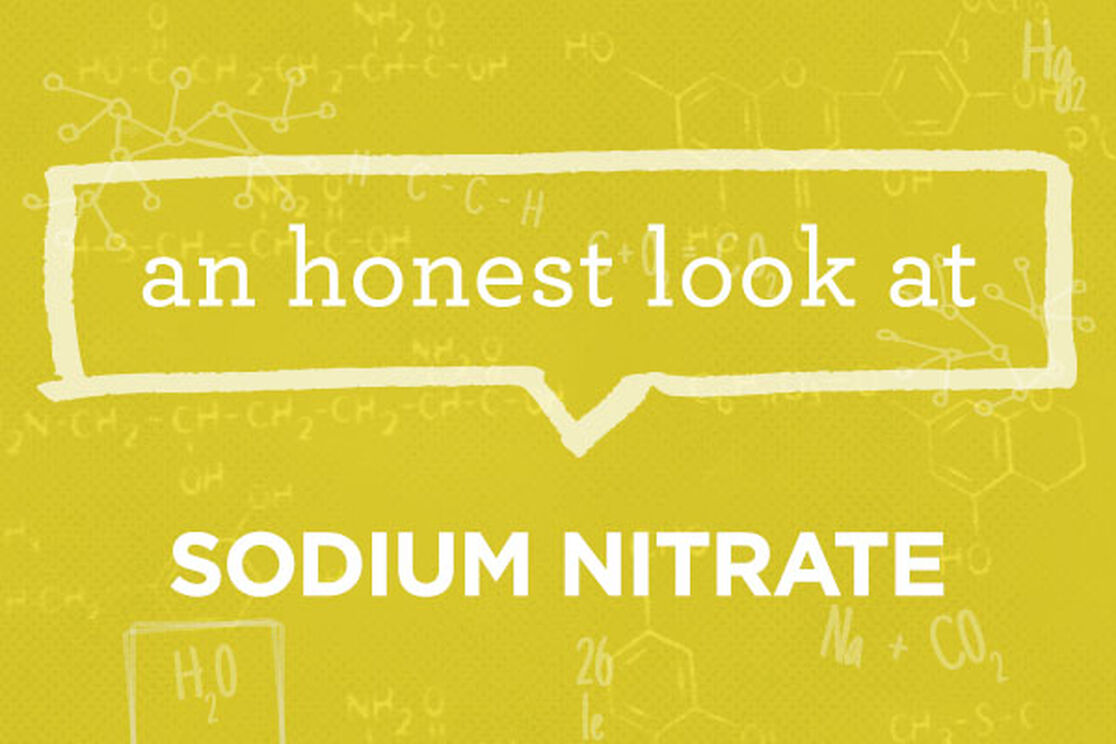This is part of our ongoing series helping consumers better understand chemicals, chemistry, and product formulations. We translate the science, bust the myths, and give you an honest assessment, so you can make informed choices for your family!
Ingredient:
Sodium Nitrate
What it is:
Sodium nitrate is a form of salt also known as Chilean saltpeter due to the large natural deposits found in Chile (1).
What it does:
This salt is used for a variety of purposes including as a food additive, a preservative, and a fertilizer that helps restore nutrient levels in soil (2).
Sodium nitrate and sodium nitrite as used in processed meats have been under scrutiny for quite some time, but the body of science that has emerged over the past 15 years has resulted in a paradigm shift of understanding as evidence comes to light that they could actually be beneficial for health (3-9). Here are a few quick facts:
- Sodium nitrate turns into sodium nitrite in the body, which can then form either nitric oxide (good) or nitrosamines (bad). Previously, it was assumed that stomach acid turned the nitrite into toxic nitrosamines (3). Now the evidence is pointing the other direction and finding it generally turns into nitric oxide, which has health benefits (3).
- While eating too many processed meats (that use sodium nitrate and sodium nitrite as preservatives) has been potentially linked to negative health impacts like cancer, the cause is still unclear and likely isn’t due to just the presence of nitrates (10,11). (For those of you who buy “nitrate-free” processed meats, the preservative substitute is typically celery powder because it’s high in sodium nitrate (12). Sometimes the “nitrate-free” options have higher levels of sodium nitrate than the regular meats (12).)
- Celery, spinach, lettuce, beets, radishes, melon, turnip greens, and rhubarb all have high levels of nitrates (13).
- Over 85% of nitrate consumption is from eating vegetables (13).
- The human body also naturally creates sodium nitrate (13).
Scientists are increasingly exploring the potential health benefits of sodium nitrate and we’re watching closely to see what’s revealed (14-19).
Why we use it:
We use sodium nitrate as a thickening agent in some of our bath and body products. Given the body of research that’s been emerging over the past 15 years, we’re confident in the safety of it as used in a skin or hair care formula.
References:
- Wisniak, J., & Garces, I. (2001). The rise and fall of the salitre (sodium nitrate) industry. Indian journal of chemical technology, 8(5), 427-438.
- International Plant Nutrition Institute. (n.d.) Sodium Nitrate. Retrieved February 28, 2016, from https://www.ipni.net/publication/nss.nsf/0/559A41F30743EACB85257B20007AAEDF/$FILE/nss-24%20SN.pdf
- Bryan, N. S., Alexander, D. D., Coughlin, J. R., Milkowski, A. L., & Boffetta, P. (2012). Ingested nitrate and nitrite and stomach cancer risk: an updated review. Food and Chemical Toxicology, 50(10), 3646-3665.
- Maekawa, A., Ogiu, T., Onodera, H., Furuta, K., Matsuoka, C., Ohno, Y., & Odashima, S. (1982). Carcinogenicity studies of sodium nitrite and sodium nitrate in F-344 rats. Food and Chemical Toxicology, 20(1), 25-33.
- Larsen, F. J., Ekblom, B., Sahlin, K., Lundberg, J. O., & Weitzberg, E. (2006). Effects of dietary nitrate on blood pressure in healthy volunteers. New England Journal of Medicine, 355(26), 2792-2793.
- Archer, D. L. (2002). Evidence that ingested nitrate and nitrite are beneficial to health. Journal of Food Protection®, 65(5), 872-875.
- Little evidence of harm at the levels we’re exposed to and might actually be beneficial for health. Katan, M. B. (2009). Nitrate in foods: harmful or healthy?. The American journal of clinical nutrition, 90(1), 11-12.
- Hord, N. G., Tang, Y., & Bryan, N. S. (2009). Food sources of nitrates and nitrites: the physiologic context for potential health benefits. The American journal of clinical nutrition, 90(1), 1-10.
- McKnight, G. M., Duncan, C. W., Leifert, C., & Golden, M. H. (1999). Dietary nitrate in man: friend or foe?. British Journal of Nutrition, 81(05), 349-358.
- Chan, D. S., Lau, R., Aune, D., Vieira, R., Greenwood, D. C., Kampman, E., & Norat, T. (2011). Red and processed meat and colorectal cancer incidence: meta-analysis of prospective studies. PloS one, 6(6), e20456.
- Cross, A. J., Leitzmann, M. F., Gail, M. H., Hollenbeck, A. R., Schatzkin, A., & Sinha, R. (2007). A prospective study of red and processed meat intake in relation to cancer risk. PLoS Med, 4(12), e325.
- Mason, J. B. (2014.) Ask Tufts Experts. Tufts University Health and Nutrition Letter. Retrieved February 28, 2016, from http://www.nutritionletter.tufts.edu/issues/10_7/ask-experts/1499-1.html
- National Academies Press. (1995.) Nitrate and Nitrite in Drinking Water. Retrieved February 28, 2016, from http://www.nap.edu/read/9038/chapter/7
- Lundberg, J. O., Carlström, M., Larsen, F. J., & Weitzberg, E. (2011). Roles of dietary inorganic nitrate in cardiovascular health and disease.Cardiovascular research, 89(3), 525-532.
- Larsen, F. J., Weitzberg, E., Lundberg, J. O., & Ekblom, B. (2007). Effects of dietary nitrate on oxygen cost during exercise. Acta physiologica, 191(1), 59-66.
- Weitzberg, E., & Lundberg, J. O. (2013). Novel aspects of dietary nitrate and human health. Annual review of nutrition, 33, 129-159.
- Lundberg, J. O., Feelisch, M., Björne, H., Jansson, E. Å., & Weitzberg, E. (2006). Cardioprotective effects of vegetables: is nitrate the answer?. Nitric Oxide, 15(4), 359-362.
- Machha, A., & Schechter, A. N. (2012). Inorganic nitrate: a major player in the cardiovascular health benefits of vegetables?. Nutrition reviews, 70(6), 367-372.
- Bryan, N. S., & van Grinsven, H. (2013). The role of nitrate in human health.Advances in Agronomy, 119(4), 153-182.
We aim to provide you with the most honest and credible information possible. This article was reviewed for accuracy by The Honest Team and was written based on sources that are linked at the bottom of the article.
blog_review_statement



